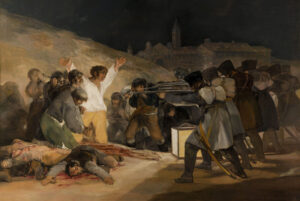In February 1914, as his son prepared for the War Academy entrance examination, General Helmuth von Moltke (the younger) sent him a book and a word of advice: Study Cannae. The book was not an eyewitness account of the battle (though Hannibal’s own narrative was thought to exist); rather, it was the highly regarded masterwork of General Alfred von Schlieffen, the former chief of the German general staff.
Schlieffen’s studies of encirclement battles had led to his “Cannae concept,” the idea that envelopment and annihilation are the highest aims in battle, and subsequently to the Schlieffen Plan, the basis for German strategic doctrine on the eve of World War I.
But why Cannae? Why had a battle fought in antiquity fired Schlieffen’s imagination? The answer lies in the romance of Cannae, in the history of the German army, and in the experiences of Alfred von Schlieffen.
Hannibal’s victory over Rome is the stuff of legend. There is the leader: a young man marked by brilliance. There is the foe: a superior army motivated by crisis. There is the tactic: a double envelopment choreographed to perfection. Finally, there is the result: total annihilation. This is the sequence that appealed to Schlieffen (as it has to military leaders through the ages); and it was particularly appealing because it offered, in a single afternoon, a model for German military experience.
Frederick the Great of Prussia (1712-86), the embodiment of that experience, was a man of Hannibalic daring. More to the point, his tactics resembled the Carthaginian’s–tactics that, more than anything, gave structure to the Cannae concept.
Frederick often coupled astonishing speed with the oblique order, a staggered advance that placed the extremities of his wings at the most forward positions. The maneuver is best illustrated by the Battle of Leuthen, in December 1757. It resembled Cannae in that Frederick, outnumbered, drew the Austrians forward and then launched a flank assault, ultimately inflicting eight times as many casualties as he suffered. He won with envelopment, not Cannae-like double envelopment, but Leuthen and other victories still supported the Cannae concept.
The next pillar for Schlieffen’s ideas was erected by the elder Helmuth von Moltke. With Frederick’s spirit, Napoleon’s example, and industrial Prussia’s resources, Moltke conceived of war on an unprecedented scale. His doctrine, strategic envelopment, combined rapid mobilization, concentrated force, and relentless mobility to encircle and annihilate the enemy.
Strategic envelopment bore fruit at Koniggratz in July 1866, when a ponderous Austrian unified command was beset by three smaller, more mobile Prussian armies. Maneuver was impossible for the quarter-million Austrians–as it was for the Roman maniples at Cannae–and the war ended before (experience said) it should have begun.
Four years later, against the French at Sedan, Moltke repeated his success. But whereas the double envelopment at Koniggratz was reminiscent of Cannae, Sedan was a greater achievement–a Cannae-like encirclement, a victory that the official German history called “unprecedented.” Of course, its precedent was Cannae. And in duplicating Hannibal’s victory so thoroughly, Moltke’s doctrine became the irrefutable truth of the German general staff Schlieffen couldn’t help but be impressed. As a cadet he had studied Frederick. As an officer he had witnessed Koniggratz. And in 1900, nine years after becoming chief of the general staff, he read historian Hans Delbrück’s account of the Battle of Cannae. It was Delbrück who thought he had discovered Hannibal’s personal account of the battle–embedded in the narrative of the Greek historian Polybius. “I have no doubt,” he wrote, “that….we are holding in our hand, in the account of his greatest victory, a direct expression of the mind of this hero….” Delbrück argued that Cannae was the watershed battle of ancient history, not because of Hannibal ‘s victory but because of Rome’s defeat: It was so catastrophic that Rome changed her military structure–and conquered the world. Delbrück claimed that Hannibal’s success was due entirely to the cavalry attack from behind; that the infantry’s double envelopment served as a sort of caldron, containing the Romans while the cavalry exerted pressure.
When Schlieffen read this, he ordered the general staffs history section to prove that Cannae was the prototypical Western battle–and then he set about duplicating it. He had already developed a plan for an offensive against France in a vast wheeling maneuver through Belgium. But Cannae gave him new confidence in his plan, and he set down its specifics as though they were the “direct expression” of Hannibal’s mind.
In 1910, at the War Academy ‘s centennial, an aged Schlieffen announced: “In front of every…commander lies a book [on] military history…. [In it] one finds the heartwarming reality, the knowledge of how everything has happened, how it must happen, and how it will happen again.”
The Schlieffen Plan called for the German army to focus everything on a northern sweep so broad that it took in Paris. The French would be rolled up from behind, like the Romans at Cannae.
But important features of Cannae were absent. Missing was the shock of the double envelopment. Although Delbrück had regarded the infantry as a simple barrier, he had not denied that the enormity of Hannibal’s victory was due to multiple shocks. Yet Schlieffen understood him to mean that any obstacle, be it a river or a neutral country, could replace the infantry envelopment. Also missing, of course, was Hannibal, Delbrück’s heroic figure, replaced by a timetable. Cannae’s single afternoon had stretched to a grueling month; its contained field to exhausting distances; its bold risks to foolhardy gambles. Hannibal had not had to consider lunch, or railroads, or the Belgian border. MHQ
[hr]
This article originally appeared in the Summer 1990 issue (Vol. 2, No. 4) of MHQ—The Quarterly Journal of Military History with the headline: The Enduring Mystique of Cannae
Want to have the lavishly illustrated, premium-quality print edition of MHQ delivered directly to you four times a year? Subscribe now at special savings!





